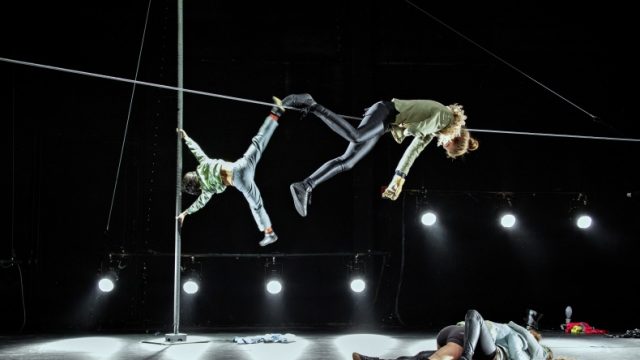Espace Chapiteau des Sablettes, Biennale Internationale des Arts du Cirque, Marseille; 4th February 2017

The show ends. The audience erupt in applause. A punch of emotion smacks me in the gut. The power caught up in this hour of high octane clowning, body-rocking, strength and struggle is released, with a glint of water in my eyes. Effet Bekkrell is my kind of feminism.
Men are not a problem. The four-woman team onstage is supported by sound designer Thomas Laigle, who manipulates the live amplification of tightwire, vertical rope, Chinese pole and suspended teeterboard, matching the crescendo of punk energy before our eyes. The absurdity of gender-based standards that evolved under a patriarchal system are, however, opened up to inspection amid the celebration of female capacity.

Fanny Alvarez, Sarah Cosset, Océane Pelpel and Fanny Sintés march into the room in power-suits of soft greens and blues, a feathered box-shoulder or blouse adding a decorative touch to the military repetitions of dance-floor moves. The internal canvas of the tent is black. The floor is black. The scaffolding and lighting rig poles are black, as are the tightwire platforms and parts laid out formally on the ground, awaiting construction. The security troupe of middle-aged men in woollen scarves and leather jackets have dispersed, and my perception of the tent has shifted to reveal a strong female space. When the lights black out, the four speedily rig their set amid low grunts and clanks.

The women all wear prominent sports gum shields, half tough, half comical. Attempts to talk through these emerge as pre-lingual signals that become more distinct as the show progresses until, eventually, the shields are discarded along with the trappings of formal pastel costume. As the company discover their own power, in their own ways, we see more red, more feathers, more sparkle, more skin. Chaos leads to revolution.

Along the way, status relations between the four play out in clown humour. Sintés’ prideful toss of the head as she climbs her rope is brilliantly funny, as is Alvarez’ attempt to cash in on Pelpel’s repeated fall from the wire as fuel for a teeterboard take-off. The stage picture is always richly balanced, and there are beautiful moments where Pelpel’s performance on the wire mirrors that of Cosset on the Chinese pole, or Sintés on the rope, switching planes from horizontal to vertical, or imitating directly. Clément Bonnin’s 3-sided lighting design gives us a stadium look, fitting for both the rock concert attitude and the sports-team camaraderie of the show.

Music throbs and lights pulse, daredevil Alvarez is launched into the air in a feathered helmet, frenzied drums and torn out lighting gels, an impassioned speech in French, repeated twice. The dangling end of a rope, one end of a system of pulleys, limply suggests a masculine power as the women speak – ‘How are you doing?’, ‘How’s your health?’ ‘ What are your hopes?’ – before they return to their own specialist areas, creating a unique soundscape of their efforts through the mic’ed equipment.
Beholden to no-one, the four finally create a self-propelled life-raft, and lift themselves away from the ground singing Tom Waits. It’s hopeful. It’s unapologetic. It’s glorious. The world needs more of this unabashed womanhood on its stages. That’s when the tears come.
.




